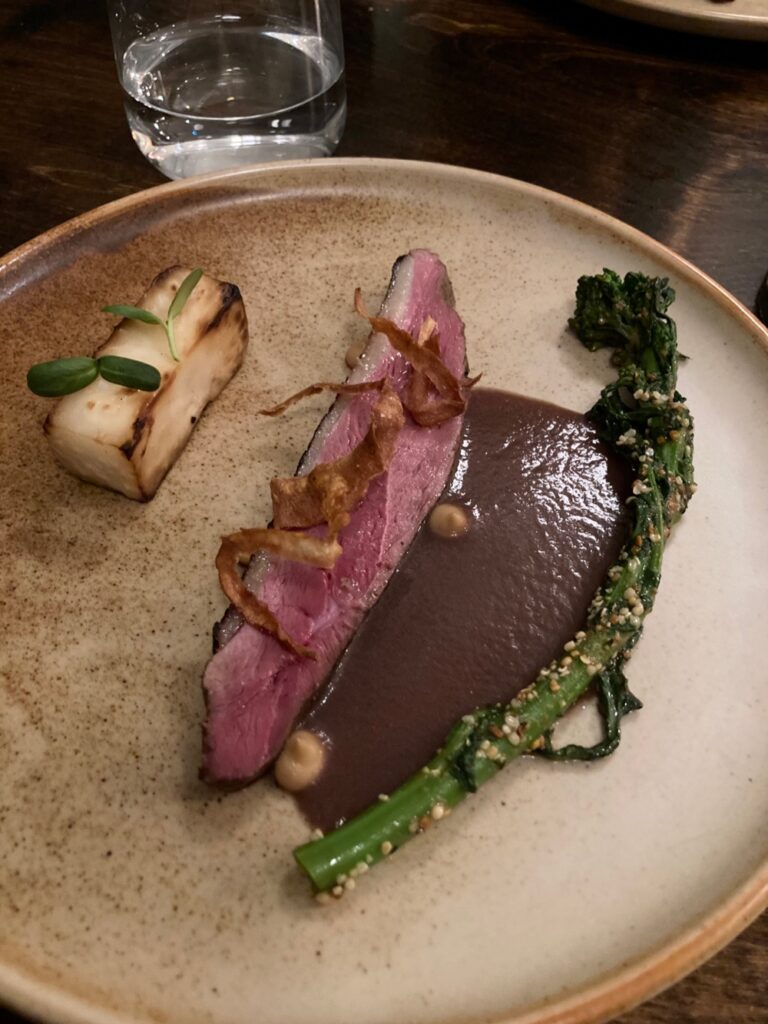
I should have known. When Nancy Matsumoto puts a new restaurant in her Top 10 list, you should probably go there. That’s what she did in 2022 when she ranked Perch in Ottawa as #4 on the Canada’s Best New Restaurants list for enRoute magazine. So it was foolish that even after I moved to nearby Gatineau, I never went out of my way to eat Chef Justin Champagne-Lagarde’s tasting menu.
Probably because it’s pricey.
It’s $145 per person for a 9-course menu, plus $100 per person for the wine/sake/cocktail pairings or $75 per person for the low-alcohol, house-made beverage pairings. What tipped the scales? A second recommendation.
I met fellow food writer Mat Beausoleil at SIAL in Montreal. He raved about Perch. I don’t want to misquote him, but I remember something about how the restaurant is too often overlooked, despite the enRoute acclaim. My thought is maybe $145 in Ottawa causes a few more bureaucratic grimaces than it does in Toronto or Vancouver (or major US or European restaurant destinations for that matter). But you only graduate from law school once (I hope), so I went for it.
It started with a phone call a week before the reservation. This wasn’t just a “We hope you’re actually going to show up” call. Instead, we talked through each intolerance, confirmed that raw leeks aren’t okay but green onions are, and that cooked garlic is fine. Would wild boar be okay despite me avoiding pork and beef? Yes, I said. I didn’t feel judged and I didn’t feel like an inconvenience, and I appreciated that, because I wasn’t hoping for a meal for 9 courses where all the tasty bits were simply removed. Too often, I end up spending a lot of money for the privilege of seeing my co-diners enjoy a meal that makes mine look like an afterthought. As though people with intolerances are meant to live with lower hopes and expectations. And sure, I understand that I can’t expect special treatment or even accommodation all the time. I make sure I say that in my reservation, because I don’t want a restaurant to compromise their vision for the food they serve. But that rare time when I get an incredible meal on par with the meal everyone else is eating, that’s special.
The real deal is when all of that consideration happens, plus each course is actually thoughtful, involves new flavours of flavour combinations I haven’t tried at home, and is balanced for saltiness, sweetness, bitterness, savouriness, spice, crunch, chewiness, softness, smoothness, cold, heat and mouthfeel. Because the best intentions don’t make a great meal. But when all that happens, then, to me, $145 is completely worth it.
That was Perch.
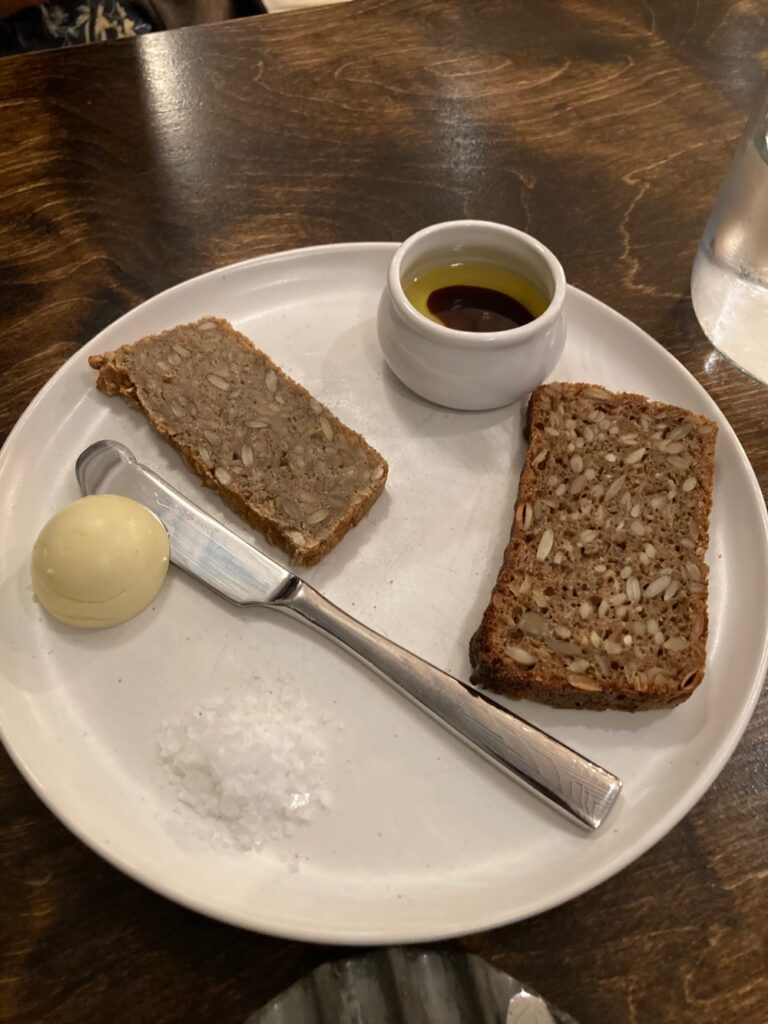
Seed bread
We started with a buckwheat-based bread with a little pot of cold-pressed canola oil with a slashed with balsamic vinegar made in Victoria, BC. I couldn’t have the butter, but I’m not complaining because that flaked sea salt was the highlight, with flat tops and bottoms that melt faster and softer into your tongue in all the salt-loving places.
I was going to skip this picture, because it was the only thing that didn’t wow in the entire meal, but it was nice to have a non-commercial gluten-free bread to start. The sunflower seeds didn’t taste like much, even with the salt, butt the subtle flavour made for a satisfying snack before the show started. It’s meant to keep your stomach from rumbling and your head from spinning from any aperitif you order before the first course hits the table. It does that.
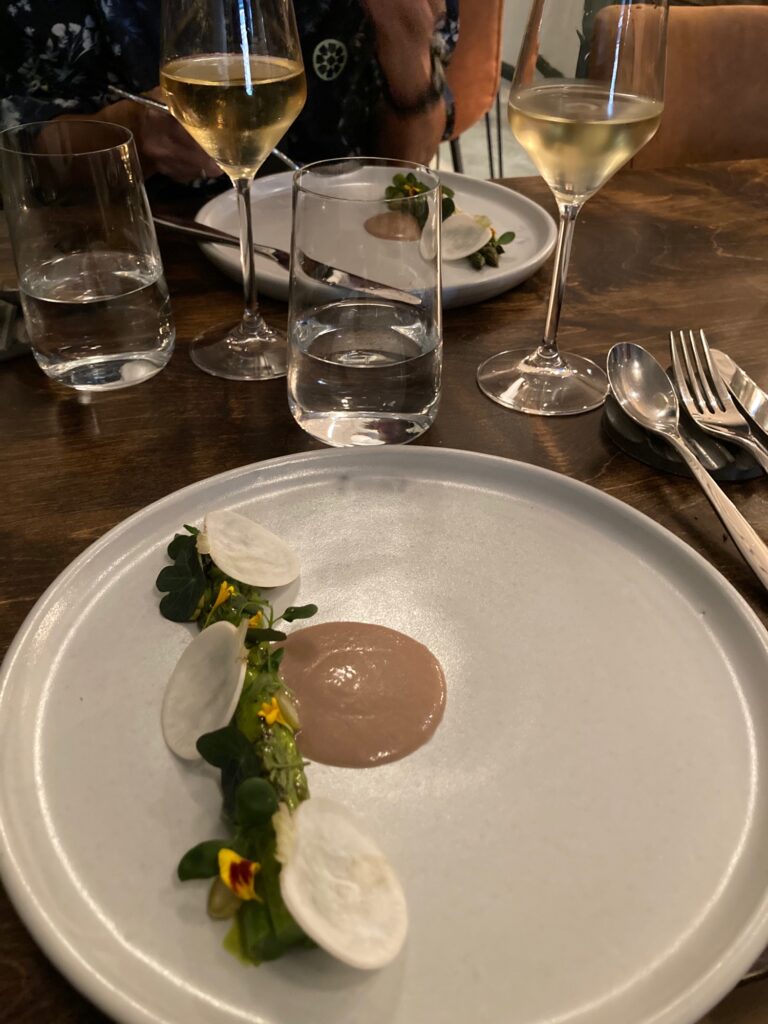
Course 1:
Here’s the where the fun began. Charred asparagus with a smoky ramp emulsion, yellow marigolds and calendula for garnish, sliced Tokyo turnips (the white circles), toon (a Chinese green, micro in this case), pieces of pickled asparagus for acidity, ramp greens emulsion (mine without heavy cream, but with a rice milk, I believe), and a chilled smoked sturgeon velouté.
A lot of restaurants are going to have grilled asparagus on the menu in late spring, but that smoked sturgeon velouté and ramps green emulsion are what made this dish shine. When I use smoked sturgeon, the result is usually overly salty and fishy. You can’t not taste sturgeon. But this velouté embodied a mother sauce at its best, with the sturgeon enhancing the umami of the sauce rather than overpowering it.
Wait! I didn’t show you the drinks menu or explain what we ordered.
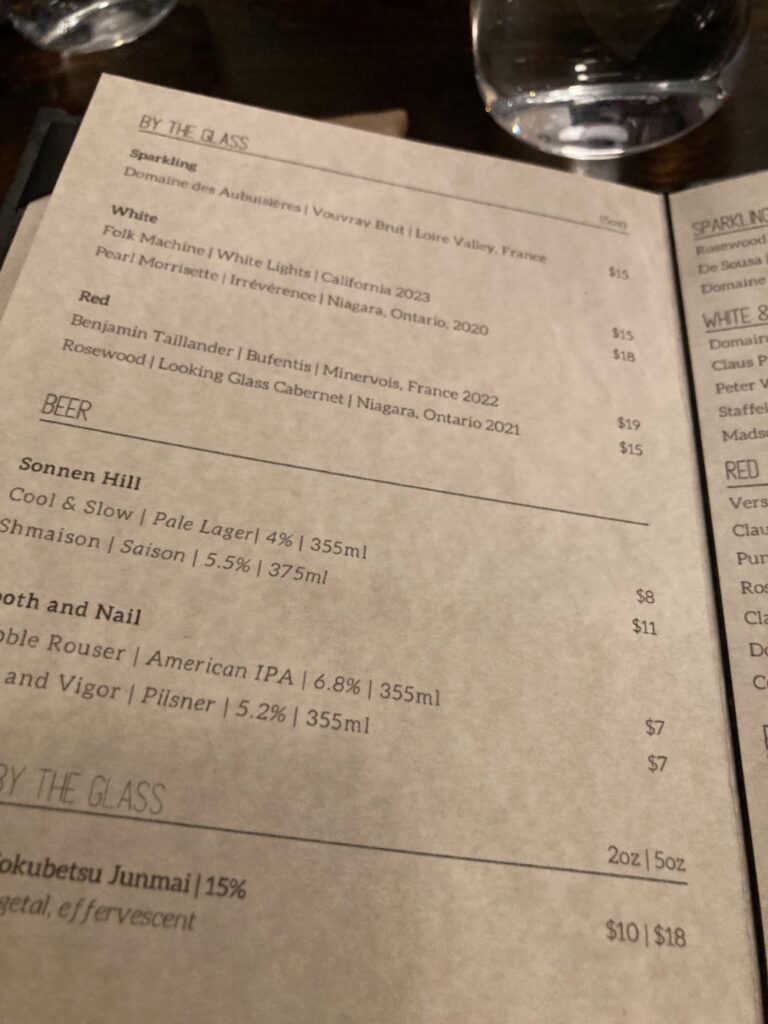
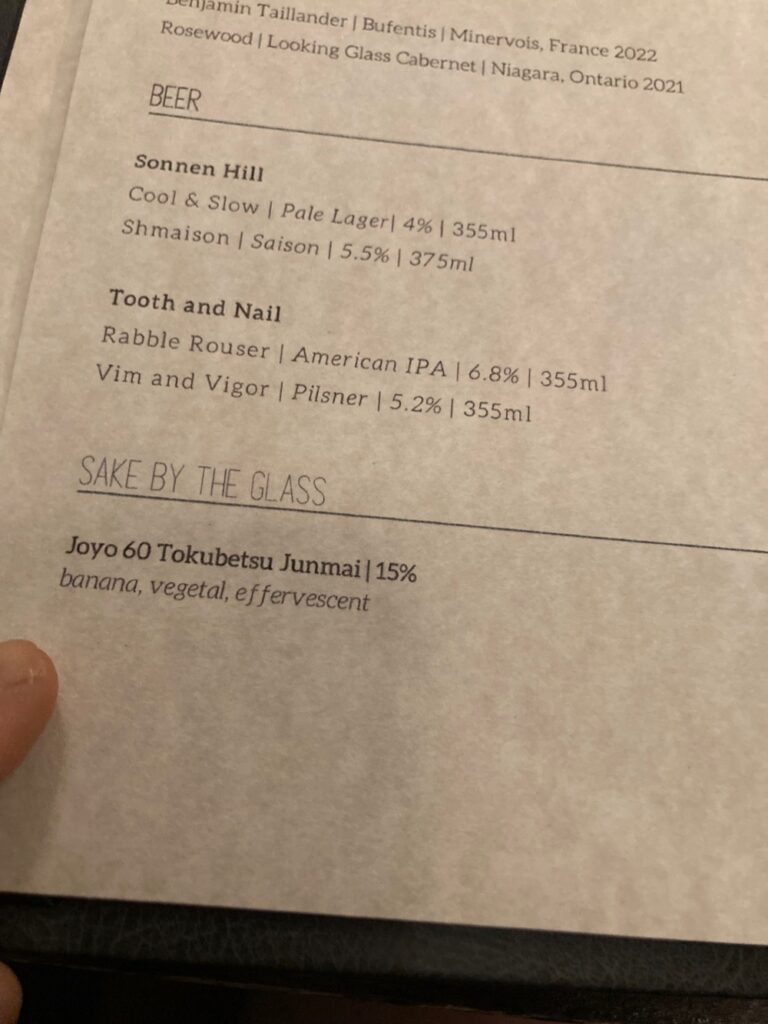
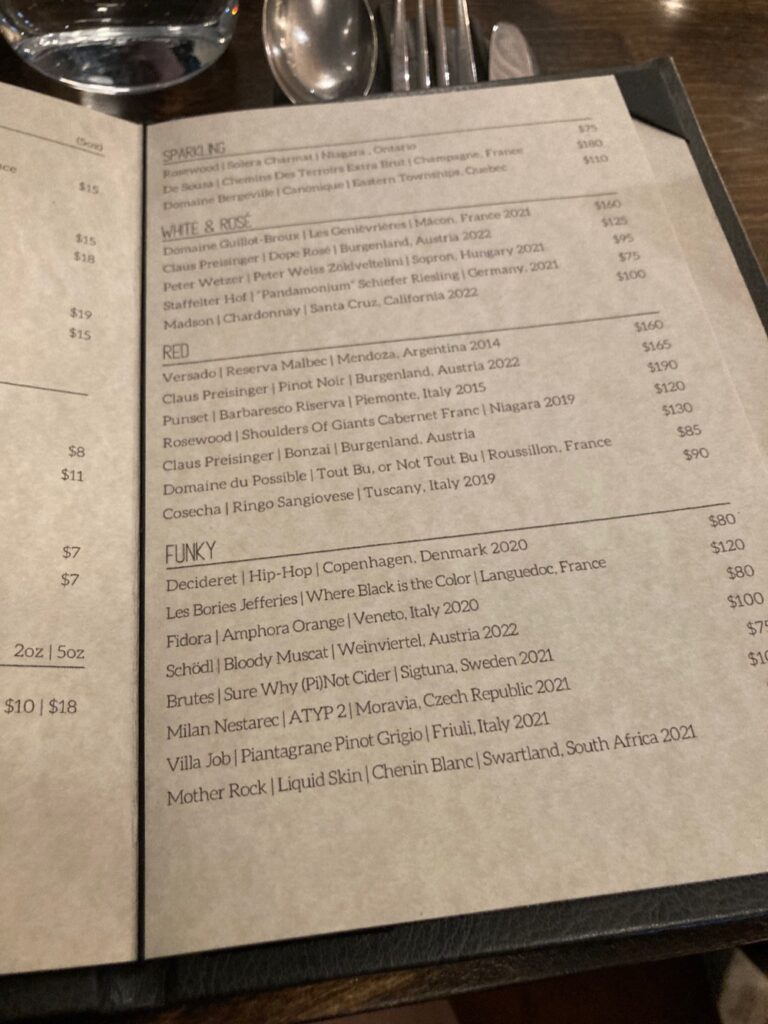
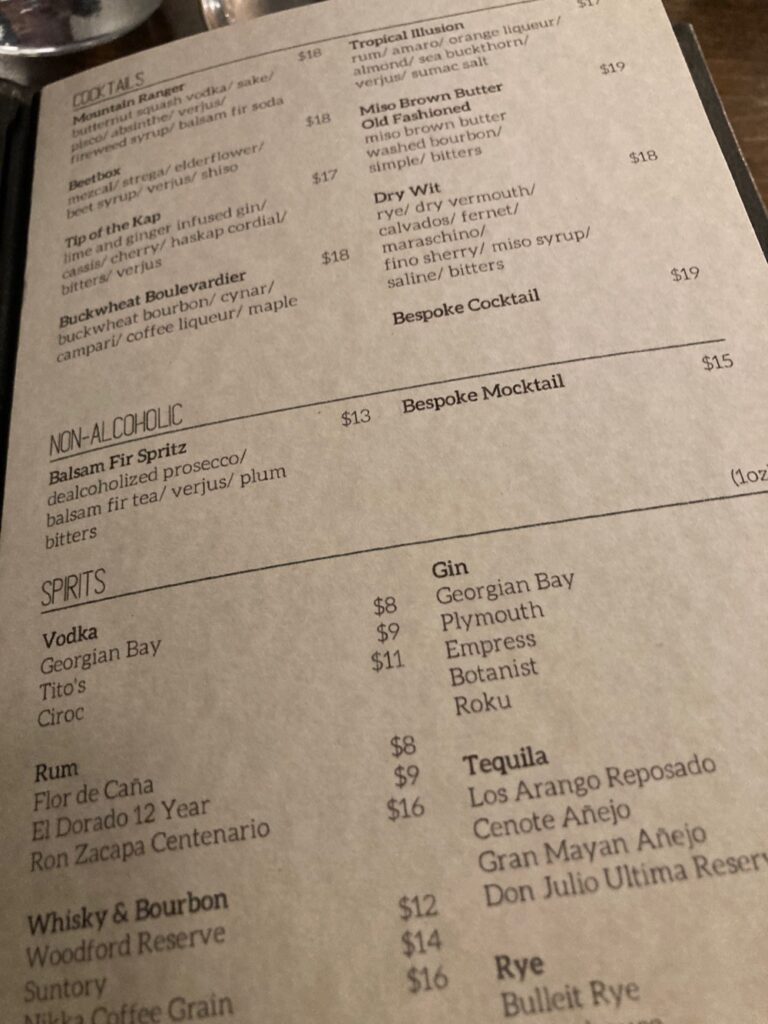
We were three, so two of us split the alcoholic pairing and one ordered a glass of the Vouvray Brut, a delicate French sparkling wine (the Vouvray is on the menu above).
We could have gotten a bottle of cult favourite Czech natural winemaker Milan Nestarec, but by splitting the drinks pairing ($50 each), we had more than enough alcohol and a lot more variety than if we’d ordered a bottle.
With our first course of asparagus, the two of us sharing the pairing got a generous half glass each of Benjamin Bridge Brut sparkling wine, a Nova Scotia wine that I first tried at the now closed Raymonds restaurant in St. John’s, NL. Or maybe I first tried it at the Canadian sparkling wine tasting conference I attended at Terroir Toronto back in 2017 (where I nervously sneaked glances over the shoulder of Gatineau’s own Master Sommelier Véronique Rivest to see what I was supposed to be tasting…).
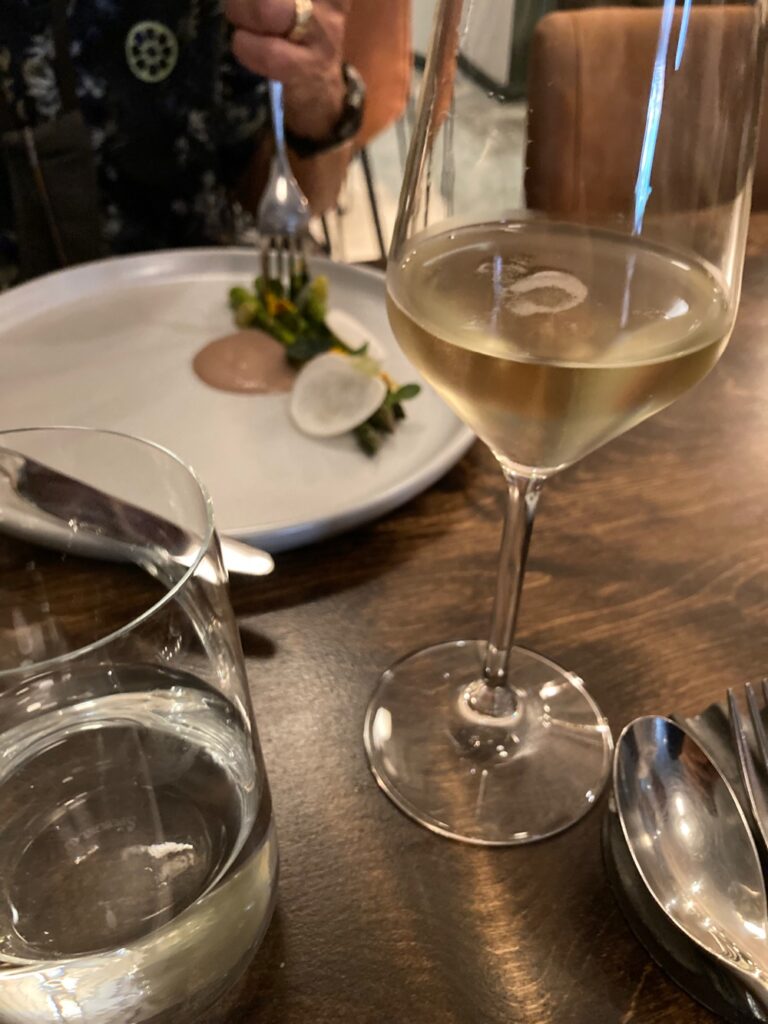
En tout cas, it was a beautiful sparkling wine then, and still is. It’s made with Chardonnay and cold-hardy Acadie grapes. It’s the méthode classique, aka “champégnoise” or “traditional”, which means the second fermentation happens inside the bottle after the wine is dosed with extra sugar and yeast. The bubbles are delicate, there’s no oakiness, and it’s on the refreshingly drier side of brut. There’s a little something in the nose adding intrigue, but no bitterness or funky aftertaste. Overall, it’s elegant, with a lower transportation cost than Champagne.
I’m not sure the Benjamin Bridge enhanced the asparagus, but sparkling goes with everything, right? So it didn’t take away from that velouté at least.
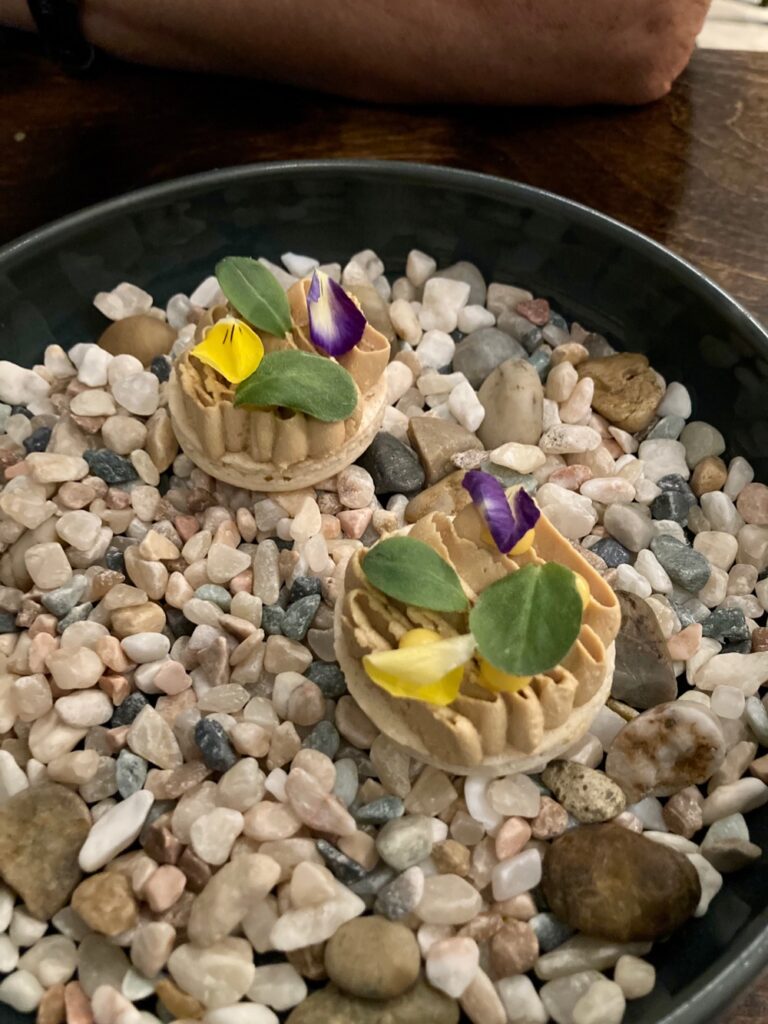
Course 2:
Macaron with Dijon and a whipped birch mousse, ground cherry gel, green borage and purple violas to garnish (one each).
I’d seen this one mentioned in reviews and was glad to see it stuck around. It’s brilliant. Often these sweet/savoury courses are far too sweet, but the hint of Dijon mustard in the macaron (with beautiful legs), the crunch of the shell, the smoothness of the piped birch mousse (how many sieves are required to make it that smooth?) and that sharp, tangy ground cherry gel to cut through the mouse’s richness and the macaron’s sweetness. Just heaven.
The Benjamin Bridge also stuck around for the pairing, which was great because it showed off how savoury the macaron really was. Ingenious pairing.
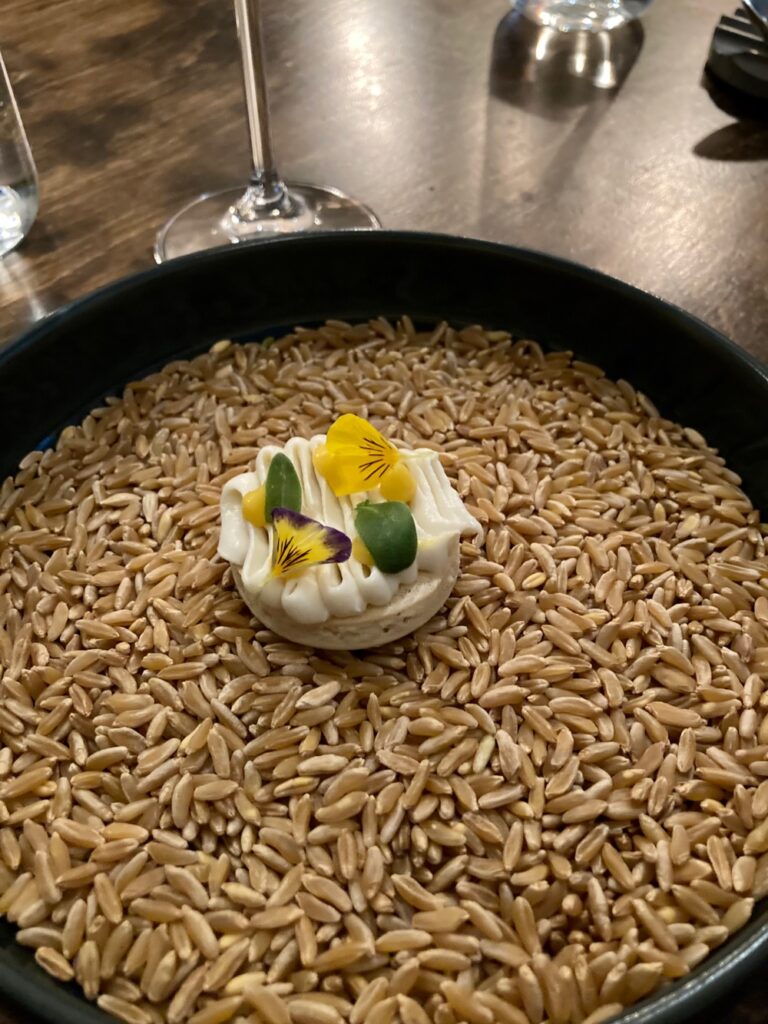
Course 3:
Chawanmushi. Another longstanding dish. This time of year it came with juicy and tender pieces of snow crab on top of the light-as-air Japanese egg custard. The walnut oil and toasted camelina seeds added more umami to the dashi in the custard. And the egg dropper of seaweed vinegar comes with the presentation to revive the egg flavour once it softens after bite 3 or so.
My favourite part of this dish (and it’s a hard call, because I do love a dramatic bowl reveal (see my Instagram for the video and DIY accoutrements) was the pairing. How someone thought to pair this with Strega, bourbon, vodka, verjus and sweet gale (like chamomile) is beyond me, but someone brilliant (I assume our sommelier) must have figured that the bitter-sweetness of the Strega and the grape versus would do something like the seaweed vinegar, but softer and sweeter.
Course 4:
Apparently I didn’t take a picture of the confit mussels in red clover dashi with dashi-steamed kohlrabi, koji, charred greens, radish, ramp bulbs, orange sea buckthorn oil and lemony sumac. The kohlrabi came in rectangular prisms, kind of matching the size and length of some of the mussels. I remember those mussels being plump and juicy, enhanced by the clear broth, and the ramp bulbs being pungent (these foraged spring vegetables resemble the bulbous white bottoms of garlic chives or scallions). The garlicky flavour stayed with me for the next two courses.
Essentially, an allium ode to spring.
This is where the sake popped up, as I hoped it would, but it wasn’t the Joyo on the menu. The Masumi Hiyaoroshi is the March pressing and autumn release of the well-known family-owned brewery in Nagano Prefecture, Japan. It’s Gingo, what Masumi is known for, with their yeast #7, with a result that’s, to me, sweet, floral, melon, and bubble gum.
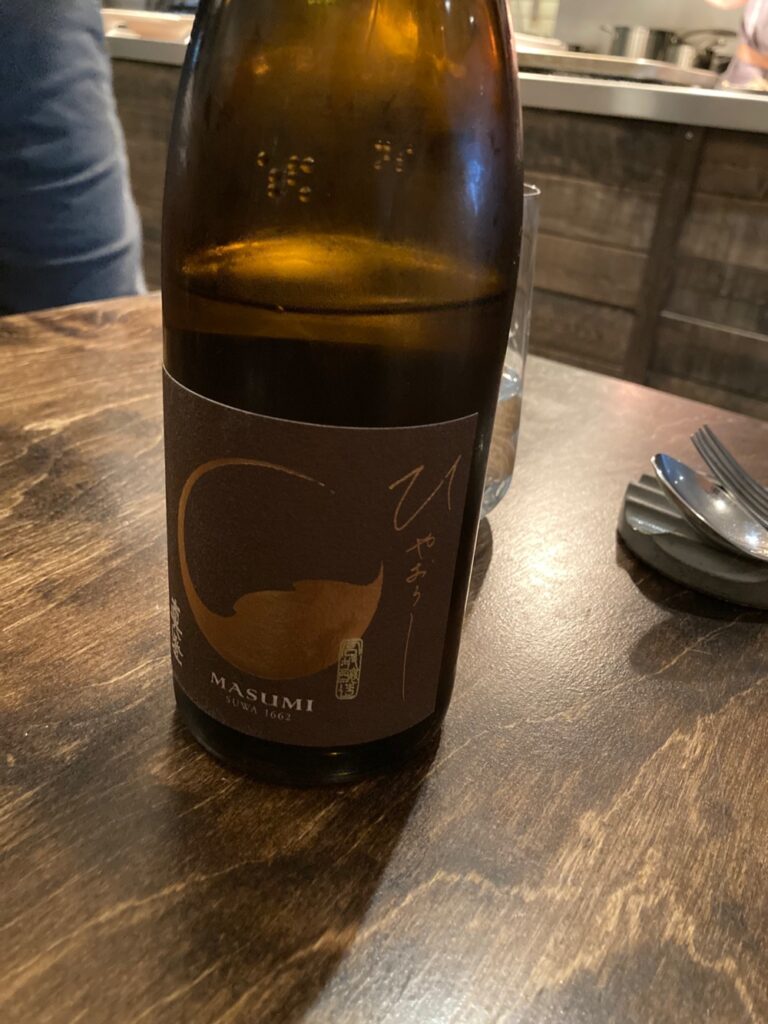
But then the sommelier popped back over with the Joyo 60 to taste for fun. I didn’t catch much effervescence (as per the drinks menu’s tasting notes), but it was less bubble gum Gingo than the Masumi, less sweet, with a softer mouthfeel.
Course 5:
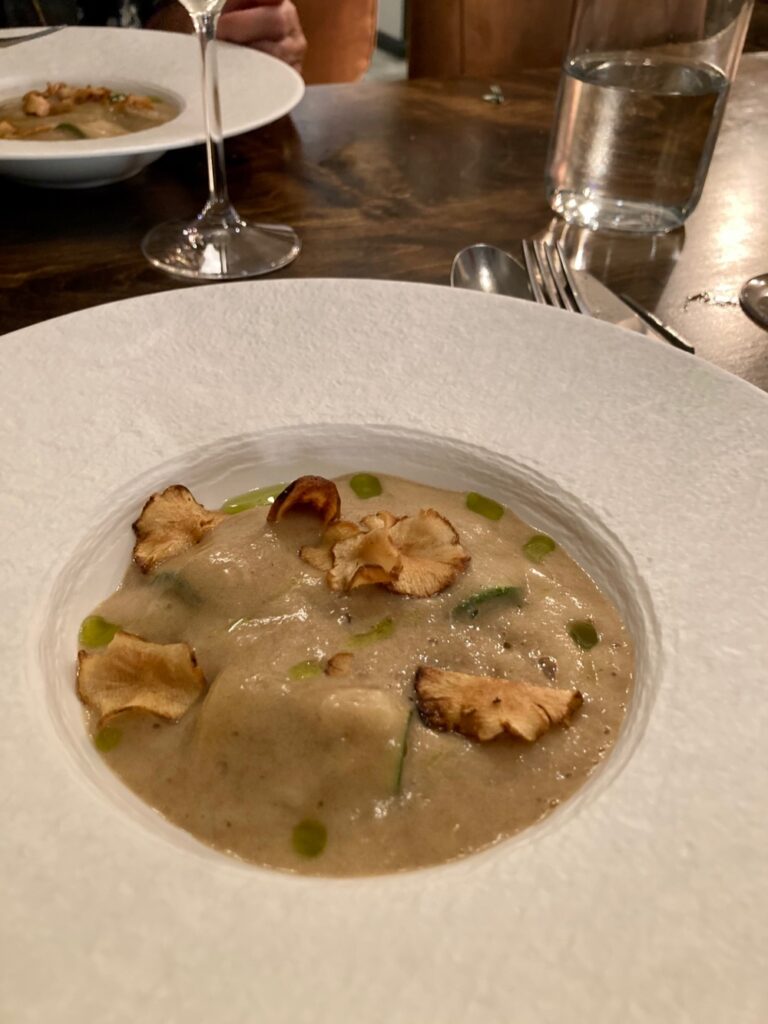
Wild boar agnolotti with roasted sunchoke and sun choke chips, confit fennel and black pearl mushrooms.
This is one dish I definitely couldn’t make at home. Partly because I don’t own a siphon and party because I just wouldn’t. There’s a lot of work involved here, roasting the Jerusalem artichokes (sun chokes), dehydrating some into chips, slow-cooking the fennel, puréeing the sauce and then chilling it in a siphon (like a whipped cream container used to aerate fatty liquids) before squeezing the trigger to extrude an ethereal sauce over homemade pasta (or in my case, tenderized zucchini) wrapped around shredded wild board meat. pasta. But before you do that, you have to make the pasta. At least I saved the sous chef the trouble on that one with my zucchini.
The meat was very dry and lean, but that wasn’t actually bad, because the more I chewed, the more the fluffy sauce moistened the meat, bringing out more flavour with each chew, and letting me sit with two different textures at once instead of just “moist.”
Amazing.
Course 6:
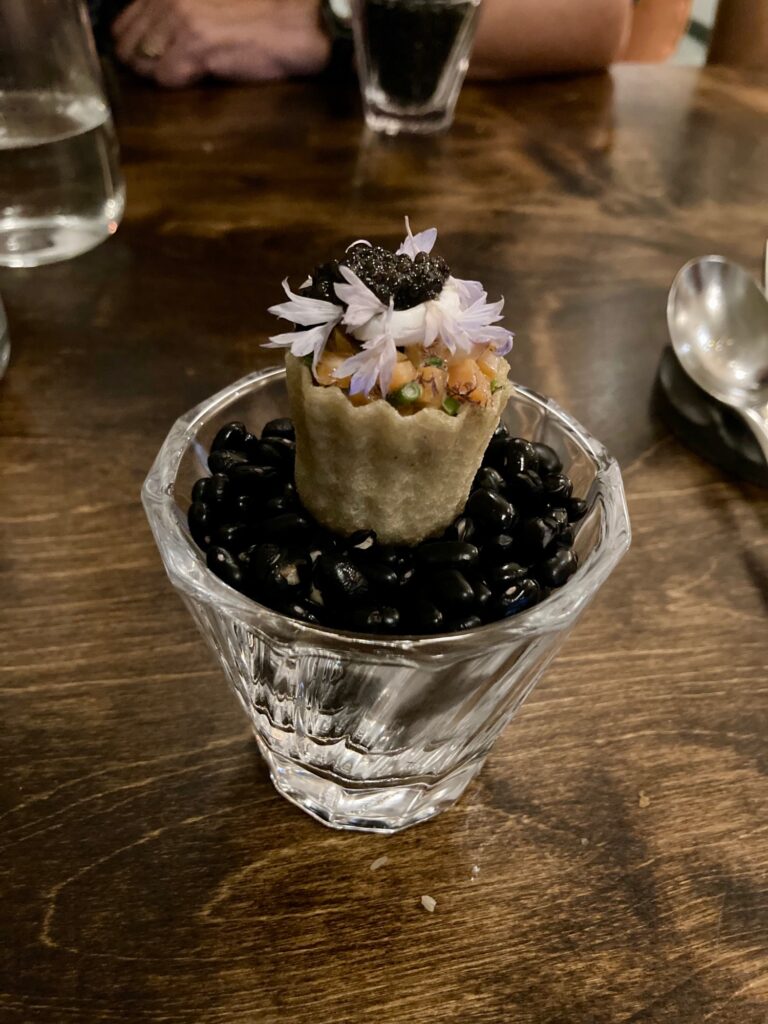
This was the one course that felt out of place for me. The dish itself was lovely, but it was a lighter flavour than the pasta, so it felt like it should have come before, not after. I understand why it did come after though: The original version of the dish that my non-GF co-diner got was made with Koji dry-aged beef instead of the brunoise roasted sweet potato I got (excellent knife skills of course). It would have been a stronger, flavour than the wild boar, I imagine, so you’d want the acidity of the cream and salty pop of the Acadian caviar to cut through. Sweet potato didn’t need that. The rest of the dish was the same: a crispy (in my case GF) cone of chives, caviar, garum, dairy-free crème fraîche (rice again, I believe) and sea truffle (a type of algae/seaweed). Mine was just felt too subtle and salty and light after those rich flavours of the pasta.
This is where I stopped taking great notes about which drink went with which course, so I’m not sure if the Japanese white wine made from the koshu grape and produced East of Tokyo was with this course or the next. I do remember that the sommelier said it was reminiscent of a vinho verde. Maybe because of the historic Portuguese influence in the area. I don’t remember too many details standing out, but I think that’s because the sweet potato didn’t need to be “cut through” like the beef would.
Course 7:
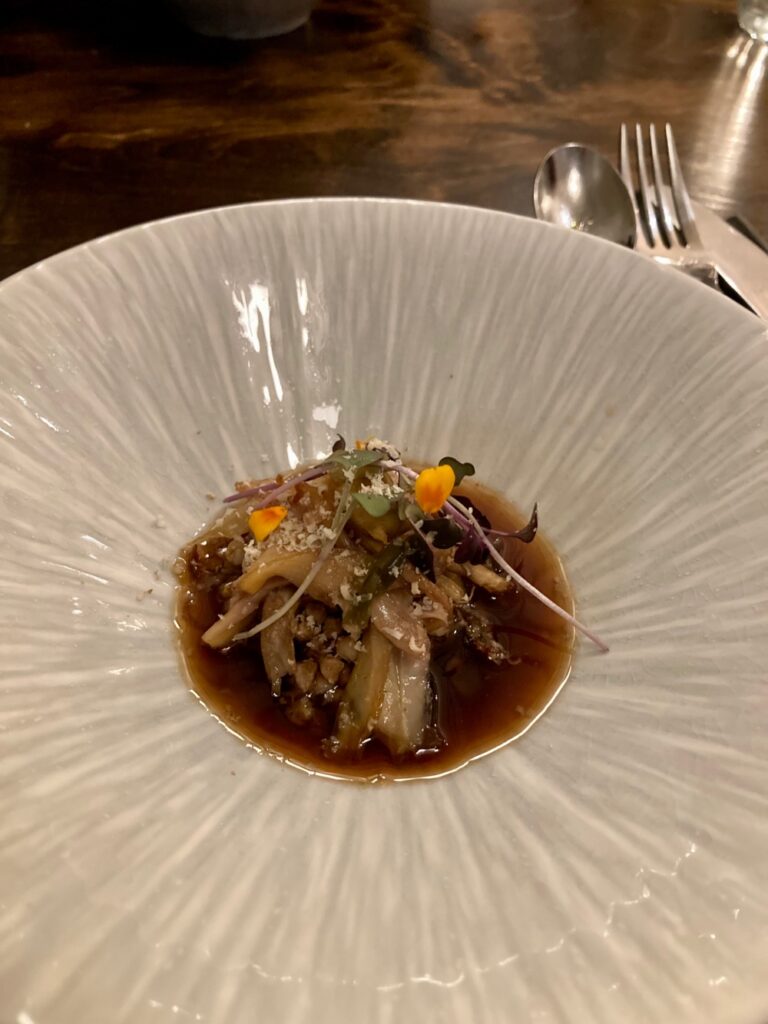
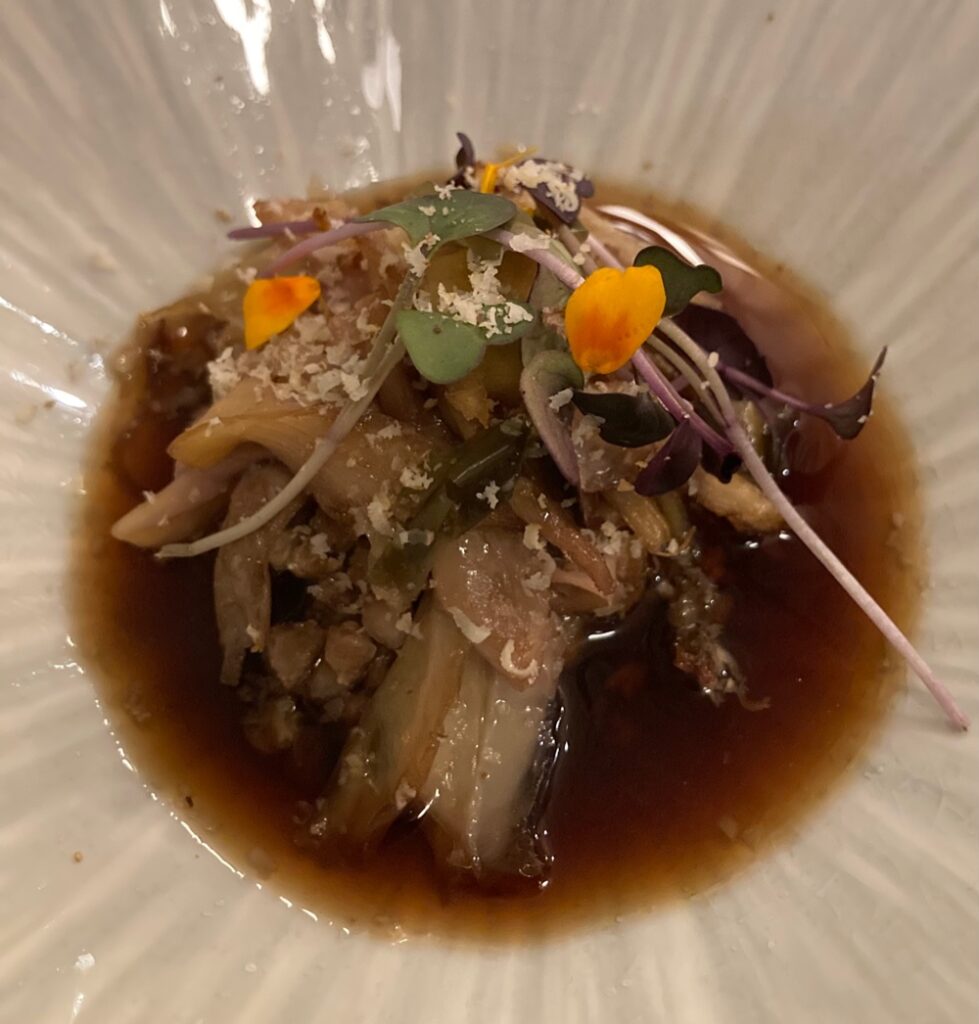
I gave the first photo above first so you don’t think this dish was massive. It was a small portion, but plenty filling, thanks to pressure-cooked buckwheat kernels soaking up a roasted allium and vinegar broth. The focus is on the Camelina-roasted mushrooms (those toothsome slices you see), topped with cabbage, pickled sea lettuce and shaved Ontario heartnuts (which I’d never heard of but reminded me of Brazil nuts in texture and mild flavour – they’re what look like Parmesan gratings).
The wine pairing was again genius. Folk Machine is a high acidity red, but it softened right down when paired with vinegar, and all of a sudden it was all gentle fruit and sweetness. I think I actually said wow.
Course 8:
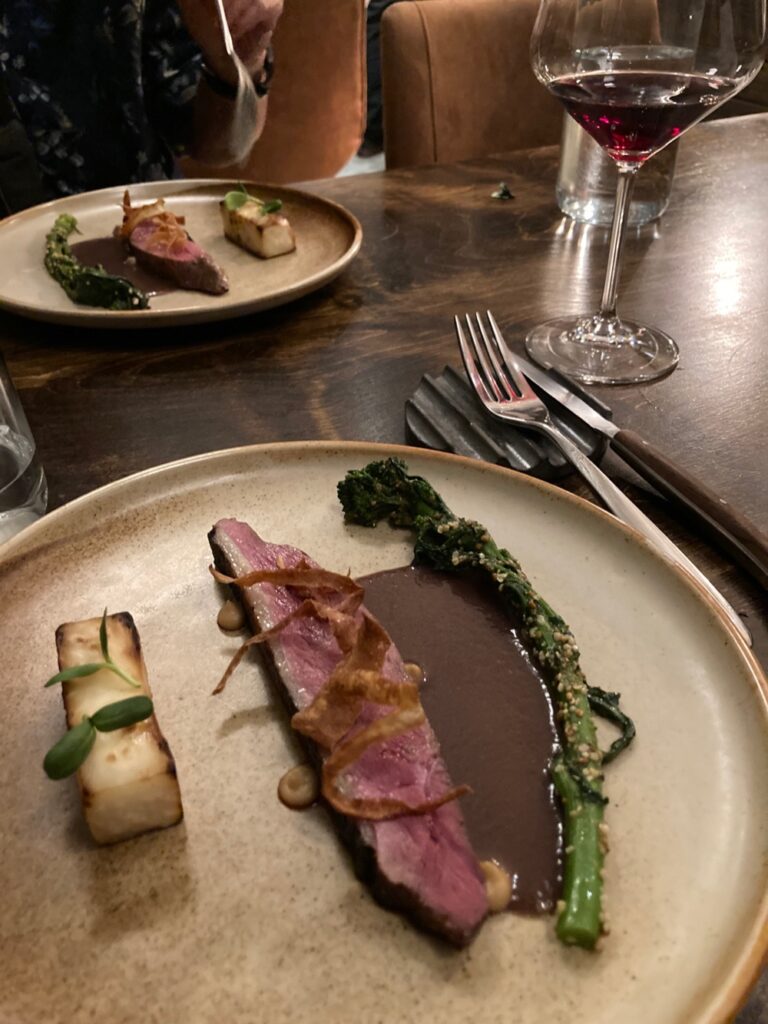
I was stuffed at this point, but when Perch puts a length of shio koji-aged sous vide duck breast (2.5 hours at 60 degrees) in front of you with a grilled rapini (rapino?) in hemp hearts, dots of caramelized parsnip purée and twirls of crispy parsnip chips, with a blueberry-balsam fir sauce… you eat it.
The fir flavour came through the sweetness of the blueberry sauce, which was more umami funk than sugar, thank goodness. And the shio koji added a miso-like fermented flavour to the meat, coating the tongue in delicious melting duck fat under the skin as you chew.
Chew. The. Fat.
The difference between my celeriac with sunflower sprouts and my neighbour’s was that mine was a block cooked confit and his was pavé in oodles of butter. The flavour pairing with the earth duck worked.
My favourite wine of the evening came now: A Sicilian volcanic soil nerello mascalese that’s gentle with dark cherry and blackberry fruity notes and then “bam!” – the tannins emerge. It makes you want another sip, and another bite.
Course 9:
Stuffed to the gills now, I’m still glad I drank this last cocktail (really, a digestif) with the chaga and sunflower cake with a black garlic and sake sorbet (the garlic is very subtle, but the sake pushes through), topped by a half shard of birch meringue. There was haskap berry in there too somewhere, though I don’t remember it, and the sauce is a nocino anglaise (walnut liqueur crème anglaise), which I definitely do remember because it was very sweet – but it needed to be because of the acidity of the sake and savouriness of the cake. I loved the mix of textures and temperatures here. Cold, melting sorbet, warm sauce, crunchy meringue, chewy cake.
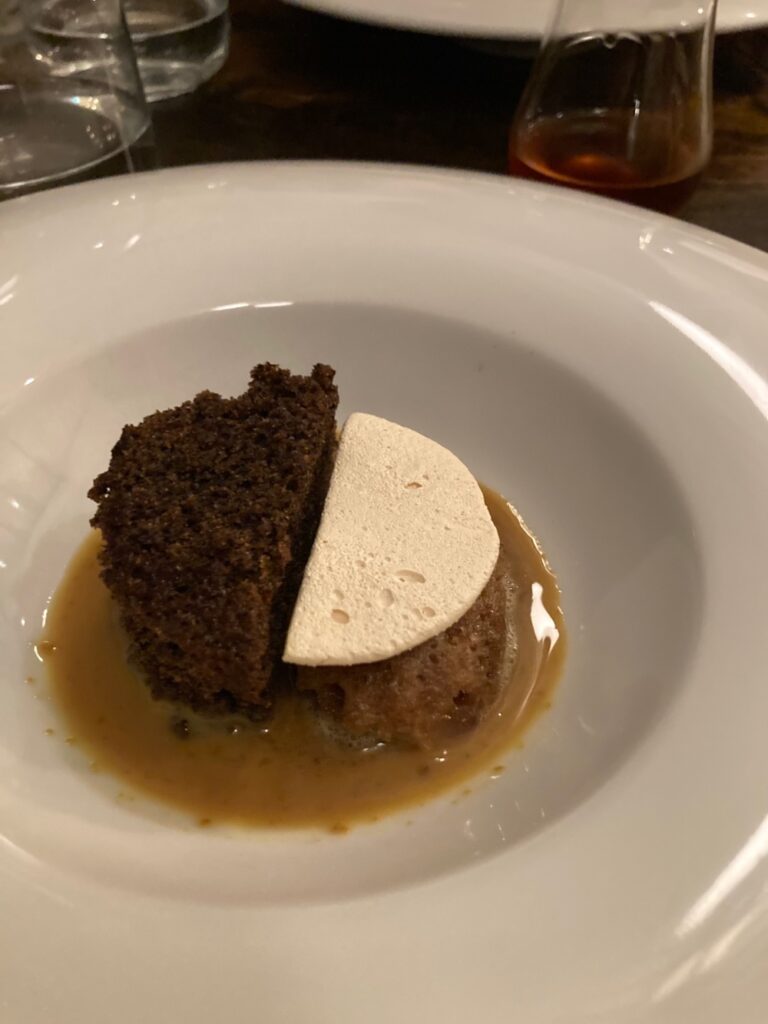
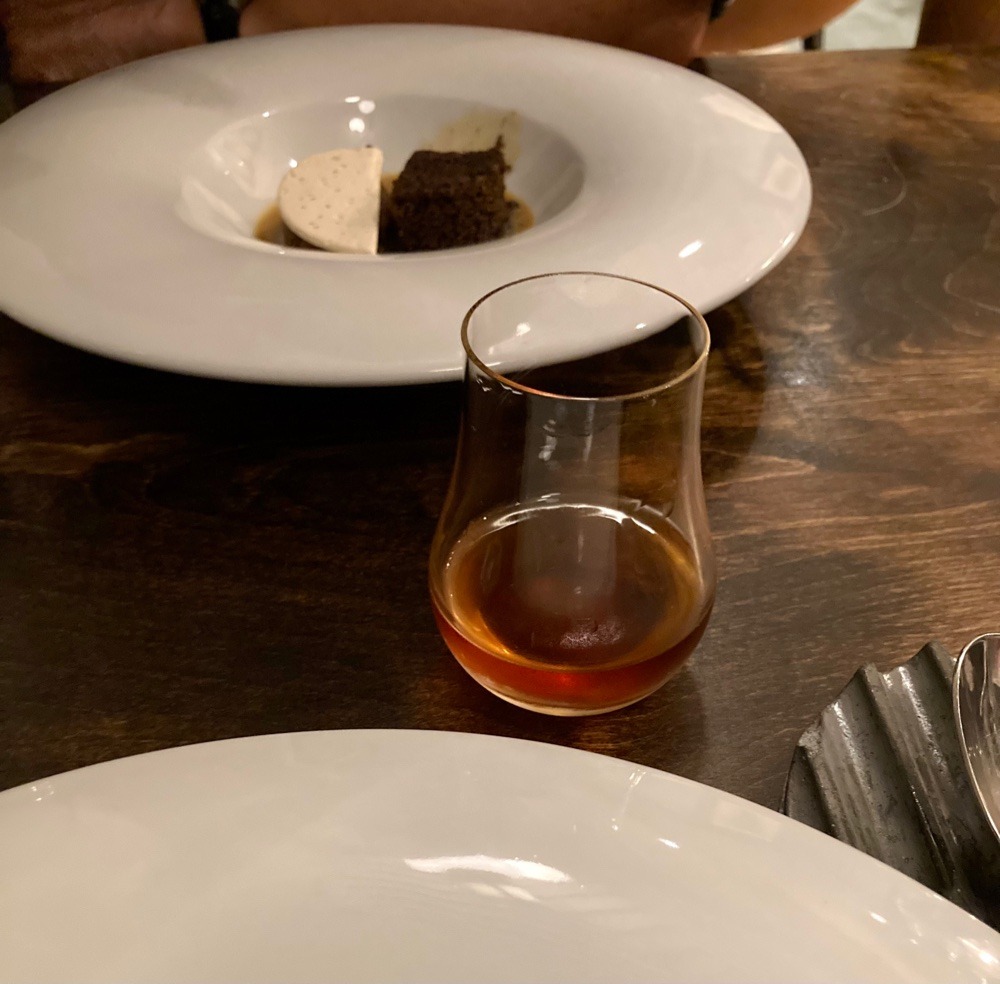
Final Thoughts
One last, last note on service. Service here is spectacular. The meal flowed smoothly. We never waited too long or too little for the next course. We never felt rushed. Instead, we felt welcome, wanted. I think if I hadn’t been so into the wines and sakes, the sommelier would have been less conversational, because he knows to let someone enjoy their experience however they want. Every plate came at the same time at every table, which sounds obvious, but isn’t obvious when you have dietary restrictions messing things up and meaning different plates are going to different people at the same table. Just the thought that went into planning my and my co-diners meals to adapt to our restrictions makes the money worth it. Too often that time isn’t remunerated, even with a good tip.
One last note on whether you should spend $145+ on this meal. I get that a lot of people will just never think this is worth the money. I could eat for at least two weeks on $145, even with grocery store inflation. But some people buy gadgets and tools and toys and books and daily coffees and clothes and others don’t think those are necessary. And maybe they’re not, but they can bring us joy. And a meal can have a lasting effect. I still remember the best meals of my life. They’re more important to me than a TV or clamping over camping. My point is that different people value different commodities differently. And we all have different tastes. Maybe the low-alcohol pairing would have been too sweet for me, making the meal less phenomenal, though I don’t think so. But physical taste, not everyone likes sitting for three hours nibbling on tiny plates of food. Ever. And that’s fine.
But if you made it to the end of this blog post, you’re probably the kind of person who would value a mind-blowing meal of things you’ve never tried before and likely never will again (unless you come back – because a lot of these dishes seem to stick around with seasonal variations). And in that case, you should reserve right away, for whenever seems appropriate to you.
Perch
300 Preston Street
Ottawa, ON
perchottawa.ca
Reservations
Hours: Thursday to Sunday, 6pm-10pm
P.S. Thanks so much for the recommendation, Mat!
Leave a Reply